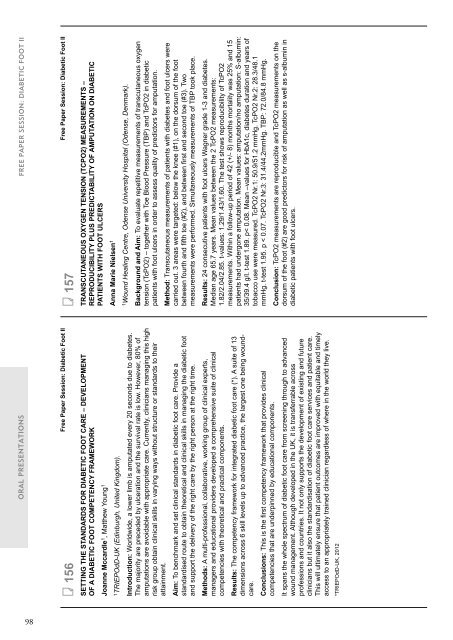You also want an ePaper? Increase the reach of your titles
YUMPU automatically turns print PDFs into web optimized ePapers that Google loves.
ORAL PRESENTATIONS<br />
156<br />
Free Paper Session: Diabetic Foot II<br />
SETTING THE STANDARDS FOR DIABETIC FOOT CARE – DEVELOPMENT<br />
OF A DIABETIC FOOT COMPETENCY FRAMEWORK<br />
Joanne Mccardle 1 , Matthew Young 1<br />
1 TRIEPOdD-UK (Edinburgh, United Kingdom).<br />
Introduction: Worldwide, a lower limb is amputated every 20 seconds due to diabetes.<br />
The majority are preceded by ulceration and the survival rate is low. However, 80% of<br />
amputations are avoidable with appropriate care. Currently, clinicians managing this high<br />
risk group obtain clinical skills in varying ways without structure or standards to their<br />
attainment.<br />
Aim: To benchmark and set clinical standards in diabetic foot care. Provide a<br />
standardised route to obtain theoretical and clinical skills in managing the diabetic foot<br />
and support the delivery of the right care by the right person at the right time.<br />
Methods: A multi-professional, collaborative, working group of clinical experts,<br />
managers and educational providers developed a comprehensive suite of clinical<br />
competencies with theoretical and practical components.<br />
Results: The competency framework for integrated diabetic foot care (*). A suite of 13<br />
dimensions across 6 skill levels up to advanced practice, the largest one being woundcare.<br />
Conclusions: This is the first competency framework that provides clinical<br />
competencies that are underpinned by educational components.<br />
It spans the whole spectrum of diabetic foot care from screening through to advanced<br />
wound management. Although developed in the UK, it is transferrable across<br />
professions and countries. It not only supports the development of existing and future<br />
clinicians but it also the standardisation of diabetic foot care services and patient care.<br />
This will ultimately ensure that patient outcomes are improved with equitable and timely<br />
access to an appropriately trained clinician regardless of where in the world they live.<br />
*TRIEPOdD-UK, 2012<br />
FREE PAPER SESSION: DIABETIC FOOT II<br />
157<br />
Free Paper Session: Diabetic Foot II<br />
TRANSCUTANEOUS OXYGEN TENSION (TcPO2) MEASUREMENTS –<br />
REPRODUCIBILITY PLUS PREDICTABILITY OF AMPUTATION ON DIABETIC<br />
PATIENTS WITH FOOT ULCERS<br />
Anna Marie Nielsen 1<br />
1 Wound Healing Centre, Odense University Hospital (Odense, Denmark).<br />
Background and Aim: To evaluate repetitive measurements of transcutaneous oxygen<br />
tension (TcPO2) – together with Toe Blood Pressure (TBP) and TcPO2 in diabetic<br />
patients with foot ulcers in order to assess quality of predictors for amputation.<br />
Method: Transcutaneous measurements of patients with diabetes and foot ulcers were<br />
carried out. 3 areas were targeted: below the knee (#1), on the dorsum of the foot<br />
between fourth and fifth toe (#2), and between first and second toe (#3). Two<br />
measurements were performed. Simultaneously measurements of TBP took place.<br />
Results: 24 consecutive patients with foot ulcers Wagner grade 1-3 and diabetes.<br />
Median age 65.7 years. Mean values between the 2 TcPO2 measurements:<br />
1.82/2.04/2.85. t-values: 1.29/1.43/1.60. The test shows reproducibility of TcPO2<br />
measurements. Within a follow-up period of 42 (+/- 8) months mortality was 25% and 15<br />
patients had undergone amputation. Mean values: amputation/no amputation: S-albumin:<br />
35/39.4 g/l. t-test 1.89. p< 0.08. Mean –values for HbA1c, diabetes duration and years of<br />
tobacco use were measured. TcPO2 Nr.1: 50.9/51.2 mmHg. TcPO2 Nr.2: 28.3/48.1<br />
mmHg. t-test 1.95. p < 0.07. TcPO2 Nr.3: 31.4/44.2mmHg. TBP: 72.0/84.8 mmHg.<br />
Conclusion: TcPO2 measurements are reproducible and TcPO2 measurements on the<br />
dorsum of the foot (#2) are good predictors for risk of amputation as well as s-albumin in<br />
diabetic patients with foot ulcers.<br />
98






